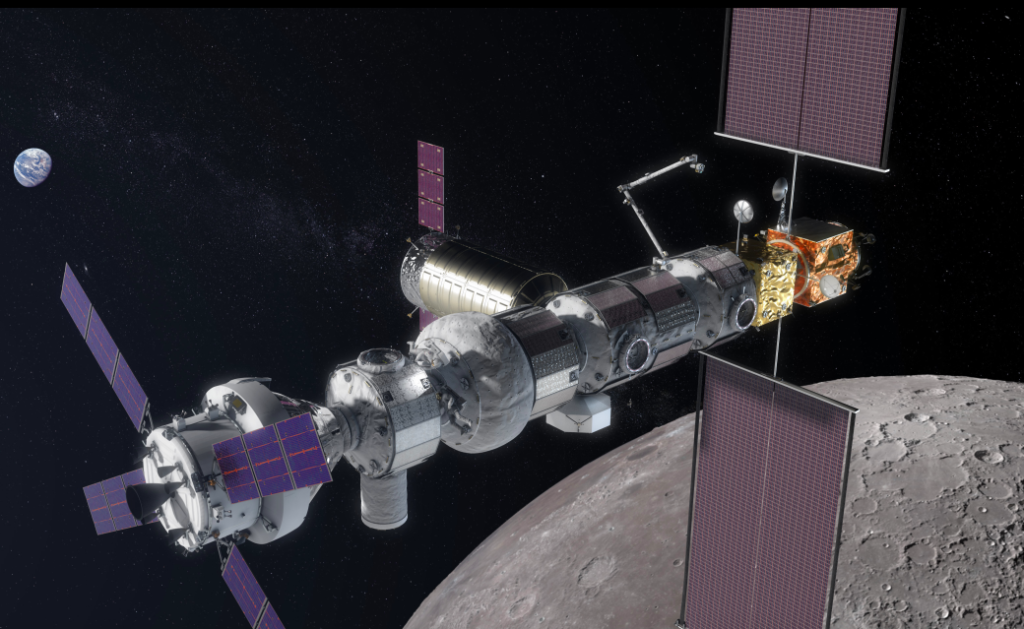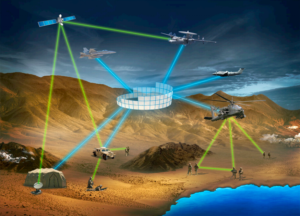
NASA’s planned Gateway station would operate in cislunar space.
WASHINGTON: The Air Force Research Laboratory’s next big space project will focus on “nontraditional orbits,” says the lab’s head of the Space Vehicles Directorate Col. Eric Felt, such as the area near the Moon and very low orbits where satellites need constant boosting to keep from plummeting back to Earth.
“The best payoff is coming from things that we’re not currently doing in space today,” Felt said of AFRL’s technology development programs for the Space Force.
The Space Vehicles Directorate is running an internal contest between four teams, one of which will prevail and be funded for a demonstration, Felt told a webinar today sponsored by Space News. He said he expects to pick a winner as early as next month, but didn’t want to go into details about the candidates.
He did note that of the four teams involved one is working on possible uses of “vLEO” — that is, very low Low Earth Orbits of around 200 to 300 kilometers above the Earth’s surface. Satellites (with the exception of short-lived experiments) rarely operate in those altitudes because they require constant propulsion to keep them from being tugged back into the atmosphere by gravity. And, historically, satellite propulsion systems were expensive and heavy.
“Now, we’ve got better technology for in-space propulsion, and it opens up this new orbital regime for potential use,” a visibly enthused Felt explained.
Another team is looking at cislunar space: the orbits between Geosynchronous Orbit, 36,000 kilometers up, and the Moon. Some definitions include orbits slightly beyond the Moon as well. As Breaking D readers know, national security space leaders are more and more preoccupied with cislunar space — seeing it as a future area of competition with China.
“We in AFRL are working on technologies to expand space domain awareness above the GEO belt — so from the GEO belt all the way to the Moon and even a little bit beyond,” he said. “It’s what we call the xGEO, or the cislunar, area of operations. And as commercial people move there, and our adversaries move there, that becomes an area where we need to know what’s going on up there.”
The Space Vehicles Directorate at Kirtland AFB has “a long history of maturing the components of satellites, and then demonstrating new capabilities on orbit with integrated flight experiments, and then transitioning those into operational capabilities,” Felt added.
The Space Vehicles Directorate is one of 10 directorates within AFRL, and, Felt said, it will remain there rather than being formally transferred to the Space Force. He explained that in March, Air Force Secretary Barbara Barrett decided that its 700 billets and the accompanying budget would be “assigned” to the Space Force, which in turn would “assign” them back to AFRL.
One savvy observer noted (rather slyly) that AFRL currently falls under Air Force acquisition chief Will Roper — who, as Breaking D readers know, has been battling internally and with Congress to avoid bifurcating the air and space acquisition chain of command. The 2020 National Defense Authorization Act (NDAA) mandates that a new Space Acquisition Executive, with a status and legal acquisition authority equivalent to that of Roper.
One of the key projects underway at AFRL crosses that air and space boundary: the so-called XVI project to test out putting a Link 16 tactical data link on Low Earth Orbit (LEO) satellites to expand connectivity across domains.

Link 16 network, Viasat image
The venerable Link 16 is the NATO standard communications link used in US and allied fighter jets and other military aircraft, as well as by ships at sea and by troops on the ground. “There are some 30,000 Link 16 radios out there,” said Felt.
However, Link 16 is a line-of-site system that often loses connectivity, especially in mountainous terrain or urban canyons. It isn’t powerful enough to use on today’s military communications satellites flying in GEO. But, Felt explained, if it could be mated with the thousands of commercial communications satellites being planned as LEO-based mega-constellations to provide global broadband connectivity — also known as “pLEO” for “proliferated LEO” — it would be a game-changer.
“You would basically have a Link 16 capability everywhere, all the time, all over the world, and that is pretty powerful enabler to our warfighters,” Felt said.
AFRL awarded Viasat a $10 million contract to put a Link 16 transponder on one of its small satellites in May 2019 as a pilot; in August Viasat tapped startup Blue Canyon Technologies to build the tiny cubesat and Roccor to build the antenna array.
Last month, Roccor announced it had finished radio frequency testing on the antenna.
“This will significantly broaden the Link 16 tactical communications network capabilities,” explained Bruce Davis, Roccor’s director of Space Antenna and Deorbit Products, in a May 19 press release. “Viasat came to us with a hard problem and a tight timeframe. They needed robust broadband capabilities – ‘big ears’ – to enable communications across a range of frequencies and they wanted to demonstrate it on a small satellite platform that is easily scalable to constellation-class missions.”
Felt said AFRL hopes to test the XVI prototype next March.
Navy jet trainer fleet operations remain paused after engine mishap
One week after the incident, a Navy spokesperson says the service is continuing to assess the fleet’s ability to safely resume flight.


























